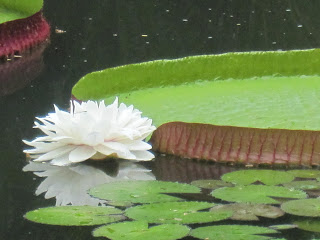Once we left
the serious business of oil production in Macae’, we drove back to Rio to stay
at the Leme Palace Hotel right on Copacabana beach. The beach is still just as
clean, the umbrellas just as colorful as before and the people just as
accommodating, laid back and friendly. We were blessed with three overcast days,
which meant that the temperatures were a relatively ‘cool’ 80 degrees.
Our first full
day was spent in a wonderland that is the Rio Botanical Gardens. The entrance
greets you with a long colonnade of Emperor Palms, which are two hundred years
old. These 100-foot tall trees literally soar into the sky with their bushy
tops gracefully shading the ground below. Your eye instantly follows the palm
procession to a bonze cast 20’ tall fountain, which is one of the main focal
points of the park.
The air smells
sweet with the fragrance of various blooming plants. Howler monkeys sit in the
trees. Toucans, those gloriously colored birds hop about in branches over your
head. Bromeliads are those unique ecosystems that nestle in cultivated
groupings and end up clinging to various trees. Spanish moss drapes some trees
while others find themselves wrapped in the pre-historic sized philodendron
leaves, so large they are the size of two serving platters. There are clove
trees growing along side the two hundred year old stands of bamboo.
The bamboo
grows about two feet (30cm) a day. Even the clumping bamboo will pretty quickly
take over at that rate. I cannot imagine trying to contain running bamboo in
this tropical environment. The park is so elegantly designed that there are
lagoons with giant lily pads, so huge that they are almost three feet across
with rare white ruffled lily flowers snuggled next to them. It is fascinating
to see how they are anchored in the water.
Our favorite
spot was not the orchid house, there weren’t any or the carnivorous plant house
which again was empty or even the healing herb garden. No, the most fascinating
spot was the Brazilian Rain Forest that comes right up to the edge of the park.
This part of
the rain forest is called The Atlantic Forest. It marches down all the
mountains in Rio to the sea. But it wasn’t always so lush. Early settlers cut
all of the rain forest down to grow sugar cane and coffee. Gradually, the city
completely ran out of water. A type of desertification began to take place
because of poor farming practices. So, during the early 1800’s the emperor,
unfortunately, using slave labor, realized that without the rain forest, there
would never be water again. So he decided to remove all the sugar cane and
coffee and replant all the hillsides all over Rio with rain forest plants.
Gradually the rain forest restored itself with plants, undergrowth, vines,
succulents, and bromeliads. The insects and birds returned. Nature found
balance again and water returned to the city.
A small aqua
duct roughly 12” deep and 12” wide collects all the run off of rainwater, fog,
and moisture from the rain forest and channels it to the waterfalls and other
pathways around the park. Literally, the rainforest provides all the irrigation
for the entire park with this aqua duct, which runs through the entire 200
acres.
The waterways
wind through the tall bamboo stands, the grove of fragrant clove trees, (every
single clove leaf smells like clove!) Azalea bushes, every kind of tropical
palm, breadfruit trees with their death defying fruit are visible everywhere.
The fruit of this tree is gigantic, roughly 18-36” long and weighing in at
12-15 pounds. They grow out of the side of the tree, hanging securely by their
sturdy stems. When one of them falls to the ground, you had better hope you are
not standing nearby. That would also apply to the cannonball trees. It’s hard
to describe a fruit like this that is perfectly round, the color of dried red
mud and about 12” in diameter and very, very, heavy. Growing again, from the
tree trunk, you might be able to see 40-50 of them. They weigh roughly 10
pounds each and woe unto any one underneath them when they fall. Whenever cannonball or breadfruit falls, you
can hear the ground shake.
The Botanical
gardens are a great way to spend a glorious day in Rio for the whopping entry
fee of $3.00 a person. I think part of me needed to see that people can still
love the land, still care for nature. Way too many homeowner associations and
communities think nothing of cutting down two hundreds at once, and then wonder why their neighborhoods are hotter and
neighbors are angry. Trees facilitate a peaceful environment.
And Rio has
trees. Each street has an entire canopy of trees that shade shoppers from the
heat. These trees cool off the city, add grace and keep the air clean. Of
course the thousands of buses and cabs all run on natural gas or a blend and
pollution levels here are extremely low. Only in the many long tunnels do you
ever smell car exhaust.
The next day
was just as blessedly cool so we went to one of the central markets in downtown
Rio. I love to shop, especially in alleys, where the locals go. The buys are
better and you find truly interesting things, many of which are not made in China!
There were hat shops, bags, bars, flowers, umbrellas, and shoes. We had a great
time just watching and getting the flavor of the city.
That afternoon
we took a walking tour to an upscale neighborhood called Santa Theresa. This
wealthy area boasts $15million dollar castles for sale, that’s dollars! That
$15million dollar castle needed another $15 million to retrieve it from the
jungle. We trudged up and down this neighborhood with views of all of Rio. It
would have been a blast had it not been raining and if the cobblestone streets
had been easier to navigate in flip flops – an obvious mistake in my choice of
foot ware. Rio is 546 years old and some of the streets in this very vertical
residential area are easily nearing 200 years old. There is one interesting
irony for those well-healed souls living in mansions clinging to the outside.
The wealthy have a view of the favelas and those souls with barely running
water and little piped out sanitation have a view of the mansions.
Electrically,
it’s a zoo. . . . . Dozens of lines running onto one pole and sometimes, there
are live electric wires just laying in the street!
Next Week Part 3













No comments:
Post a Comment